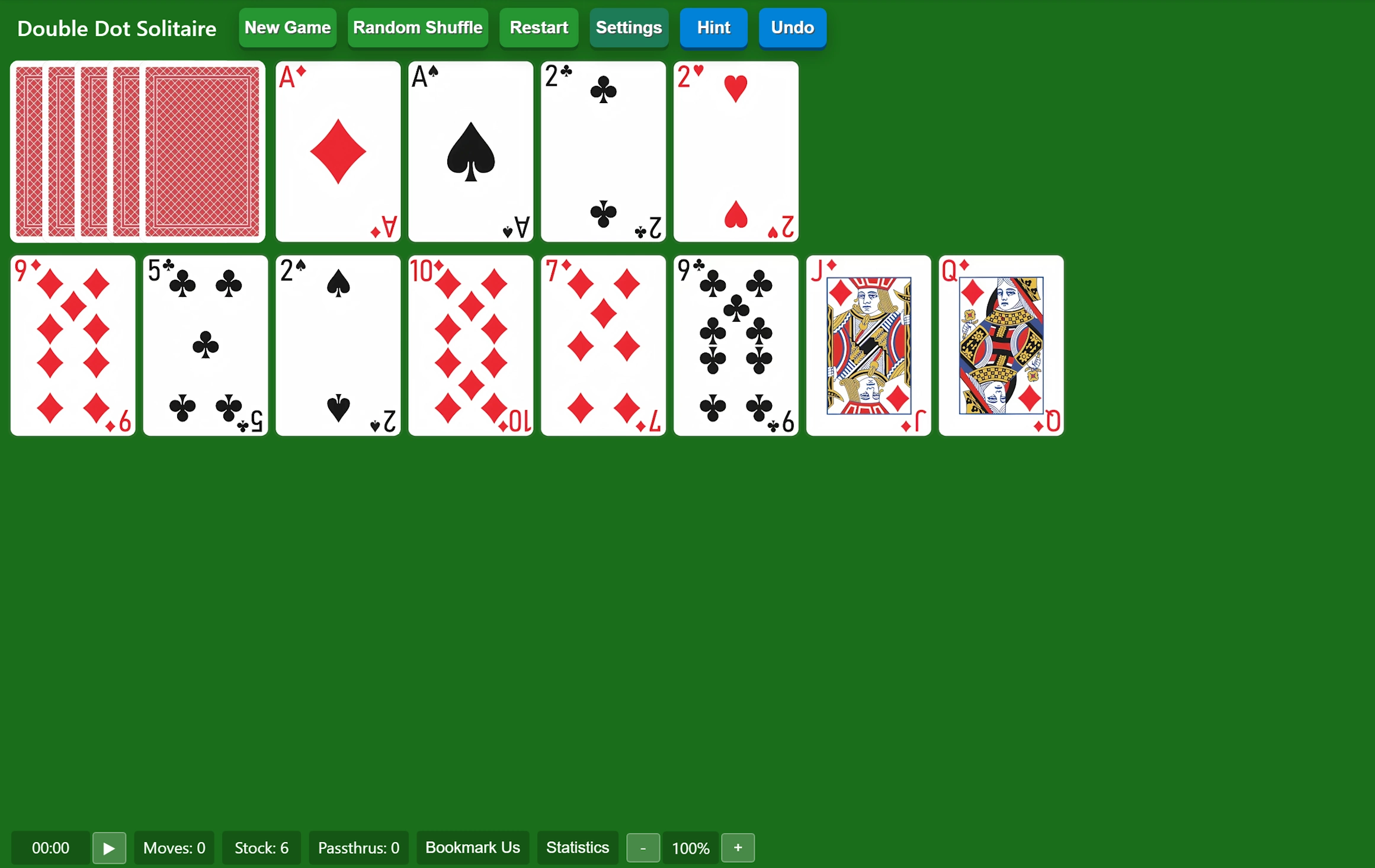🎯 Double Dot Solitaire
Play the quick‑thinking “count‑by‑twos” solitaire right here on https://solitairen.com/double-dot-solitaire. Ready, set, shuffle! ♠️♥️♣️♦️
Looking for other challenges? Discover 130‑plus solitaire titles at SolitaireX.io.
✨ At‑a‑Glance
| ⏱ Avg. Game | 🥇 Win Rate* | 🃏 Decks | 🔄 Redeals |
|---|---|---|---|
| 3‑5 minutes | ≈ 98 % * | 1 standard deck | None |
*Win‑rate figure comes from large on‑line samples and Goodsol statistics. (online-solitaire.com)
🎮 How to Play
-
Layout
- 4 Foundations: Left two piles start with an Ace; right two start with a Two. Build up by twos in‑suit (A → 3 → 5 … or 2 → 4 → 6 …).
- 8 Tableau piles: One face‑up card each. Build down by twos, any suit; sequences move as a unit.
- Stock: Click to deal one card onto every tableau pile; no redeals.
-
Objective – Move every card to its correct foundation pile.
-
Moves
- A 6 may sit on an 8, a Q on an A, etc. (wrap‑around permitted).
- Empty tableau spaces can take any single card or legal sequence.
- Once placed, foundation cards cannot return to the tableau.
Variant note – Some rule sets (e.g., BVS Solitaire Collection) use two decks with identical build‑by‑two mechanics.
📜 Brief History
- Patience / Solitaire emerged in Northern Europe in the late 18ᵗʰ century and spread via printed rule books and, later, Windows PCs.
- Double Dot appears only in modern software collections (Pretty Good Solitaire, BVS Solitaire, PySol, etc.). The precise inventor is unrecorded, but the earliest digital implementation traces to the mid‑1990s shareware era. BVS Development Corp. lists the game in its 1996 catalogue; Goodsol added a refined single‑deck version soon after.
👤 Who Created Double Dot?
No printed 19ᵗʰ‑century source names an originator. Most historians consider Double Dot a software‑era variant rather than a traditional, author‑attributed game.
💡 Tips & Tricks for Consistent Wins
| Tip | Why it Works |
|---|---|
| 🔍 Scan for “gaps of two” before dealing | Saving the stock until no further manual moves remain maximises visibility. |
| 🪄 Keep foundations balanced | Advancing one pile too hard may strand vital intermediates (e.g., a 7 trapped under a 5). |
| 🚚 Move whole sequences, not singles | Shifting stacks preserves tableau slots for future kings/queens wrap‑arounds. |
| ♻️ Don’t fill empty spaces too quickly | Leaving a space open lets you park awkward high cards after the next stock deal. |
| 🧮 Count remaining stock rounds | With zero redeals, project how many tableau cards you must free before the last deal. |
🏆 Advanced Strategy Nuggets
- Tableau Parity – Aim to keep “red/black” balance even though suit doesn’t matter; alternating colours distribute high & low ranks more evenly.
- Foundation Cycling – Because sequences wrap K → 2 and Q → A, late‑game progress can stall if the 2♠ or A♦ is buried. Delay moving the corresponding K/ Q until the underlying low card is exposed.
- Safe Stack Splitting – When a sequence blocks a needed card two ranks above it, split the sequence at the blocking card and rebuild it on another pile.
🎉 Why You’ll Love It
- Lightning‑fast rounds — perfect micro‑break.
- Ultra‑high solvability (≈ 98 %).
- Tactile “jump‑by‑two” logic keeps the classic solitaire feel fresh.
🔗 Play Now
👉 Launch your game: https://solitairen.com/double-dot-solitaire
🔗 Explore More
👉 Browse 130+ variations: https://solitairex.io
Have fun stacking by twos and may every game end in a swift foundation‑filling flourish!
